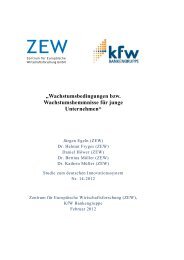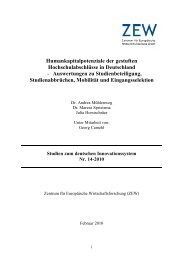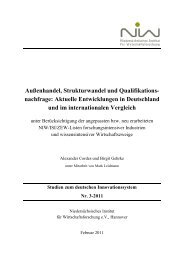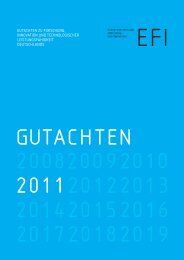research, innovation and technological performance in germany
research, innovation and technological performance in germany
research, innovation and technological performance in germany
You also want an ePaper? Increase the reach of your titles
YUMPU automatically turns print PDFs into web optimized ePapers that Google loves.
78<br />
EFI REPORT<br />
2010<br />
structure of the EPO has also proved to be problematic<br />
when it comes to decid<strong>in</strong>g on the division<br />
of labour between national offices <strong>and</strong> the European<br />
office. S<strong>in</strong>ce the national offices <strong>in</strong> the Adm<strong>in</strong>istrative<br />
Council of the EPO have the f<strong>in</strong>al say on<br />
all important matters concern<strong>in</strong>g the European office,<br />
national <strong>in</strong>terests often dom<strong>in</strong>ate. In the on-go<strong>in</strong>g<br />
discussion about the European Patent Network<br />
(EPN), some contributors are more <strong>in</strong>terested <strong>in</strong> ensur<strong>in</strong>g<br />
that the national offices are reta<strong>in</strong>ed than <strong>in</strong><br />
see<strong>in</strong>g the formation of an efficient European structure.<br />
In the course of a rational development of the<br />
European Union’s <strong>in</strong>ternal market, very small national<br />
patent offices will no longer have any significant<br />
economic role to play.<br />
Carefully develop<strong>in</strong>g patent <strong>in</strong>stitutions <strong>in</strong> the<br />
European s<strong>in</strong>gle market<br />
There are currently a number of fields <strong>in</strong> which<br />
progress seems possible towards the further development<br />
of the EU <strong>in</strong>stitutions. For example, plans<br />
have been presented to <strong>in</strong>troduce a European Union<br />
patent which would be valid <strong>in</strong> all member states.<br />
The European Commission under various Council<br />
presidencies has presented proposals for a unified<br />
patent jurisdiction. On 4 December 2009, the EU<br />
Competitiveness Council meet<strong>in</strong>g unanimously approved<br />
the measures for an enhanced patent system<br />
<strong>in</strong> Europe. 174<br />
However, there are still important aspects to be clarified,<br />
e.g. the question of language <strong>and</strong> translations.<br />
The details of the agreement will also be debated <strong>in</strong><br />
the European Parliament. An agreement on a European<br />
Union patent <strong>and</strong> unified jurisdiction will therefore<br />
<strong>in</strong>volve further negotiations between the EU member<br />
states. It is vital that the efficiency <strong>and</strong> quality<br />
orientation of the future systems should not be watered<br />
down by questionable compromises. The Federal<br />
Government should draw attention to the undisputed<br />
advantages of the German patent jurisdiction,<br />
<strong>and</strong> aim to ensure that the central Court of Justice<br />
<strong>in</strong> the new legal system is anchored <strong>in</strong> Germany.<br />
Already almost three-quarters of all patent disputes<br />
are conducted <strong>in</strong> Germany, because legal clarification<br />
can be obta<strong>in</strong>ed quickly here, cost-effectively<br />
<strong>and</strong> with a high level of expertise. A new, unified<br />
system must also offer these advantages, because<br />
otherwise it would not be possible to achieve any<br />
significant improvement. Above all, the new jurisdiction<br />
must become a guarantor for the high quality<br />
of patents. 175 National German <strong>in</strong>terests <strong>and</strong> those of<br />
the European Patent system are therefore very similar<br />
– they should be pursued skilfully <strong>and</strong> forcefully<br />
<strong>in</strong> negotiations.<br />
Recommendations<br />
– The quality orientation <strong>in</strong> the European Patent offices<br />
should be upgraded. Policy-makers must ensure<br />
that patents are only granted for <strong>in</strong>ventions<br />
which show a sufficient <strong>in</strong>ventive step. A patent<br />
system which opens its gates for marg<strong>in</strong>al contributions<br />
can become an obstacle to <strong><strong>in</strong>novation</strong>.<br />
– Patent exam<strong>in</strong>ers must be enabled <strong>and</strong> encouraged<br />
to reject marg<strong>in</strong>al patent applications. They<br />
should also be allowed to penalise malicious application<br />
behaviour.<br />
– The Federal Government should support the formation<br />
of European <strong>in</strong>stitutions <strong>in</strong> the patent system,<br />
with a uniform court system <strong>and</strong> an EU patent.<br />
It will not be possible to develop the European<br />
S<strong>in</strong>gle Market fully if these <strong>in</strong>stitutions are nationally<br />
fragmented. Efforts should be made to<br />
ensure that the new European <strong>in</strong>stitutions br<strong>in</strong>g<br />
further improvements with them <strong>in</strong> comparison<br />
with the exist<strong>in</strong>g system. Harmonisation is not<br />
an end <strong>in</strong> itself.<br />
PATENTS AS A PARAMETER OF<br />
TECHNOLOGICAL POTENTIAL<br />
The empirical registration of the <strong><strong>in</strong>novation</strong> processes<br />
still presents problems for scientists <strong>and</strong> policymakers.<br />
In recent years it has been possible to develop<br />
<strong>and</strong> test a series of <strong>in</strong>dicators, but these are<br />
subject to changes, which are be<strong>in</strong>g carefully monitored<br />
by the Commission of Experts for Research<br />
<strong>and</strong> Innovation. They <strong>in</strong>clude the changes <strong>in</strong> the motives<br />
of patent applicants mentioned above.<br />
For R&I analyses, patent offer both advantages <strong>and</strong><br />
disadvantages. The advantages <strong>in</strong>clude that datasets<br />
are readily available <strong>and</strong>, because of their legal significance,<br />
they are very reliable. In addition, the actors<br />
(<strong>in</strong>ventors <strong>and</strong> applicants) are readily identifiable.<br />
The patents can be assigned to a place of orig<strong>in</strong><br />
<strong>and</strong> a field of technology. It is also possible to iden-<br />
b 5 – 2


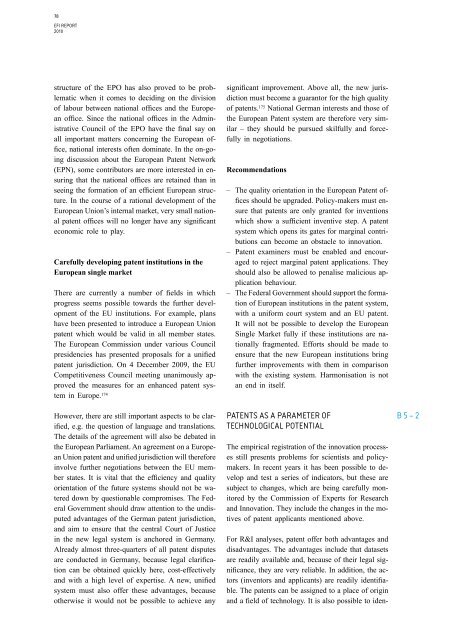
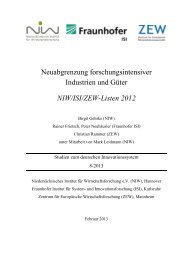
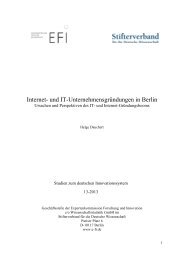

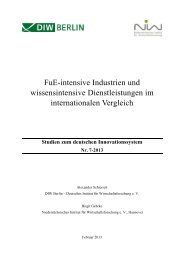
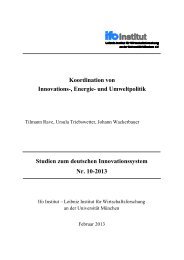
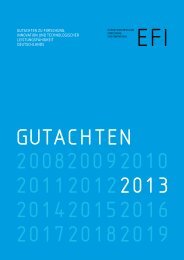
![zur Studie [Pdf, 2.574 KB] - Expertenkommission Forschung und ...](https://img.yumpu.com/20748637/1/184x260/zur-studie-pdf-2574-kb-expertenkommission-forschung-und-.jpg?quality=85)

